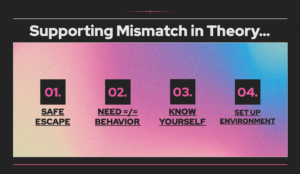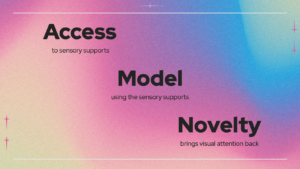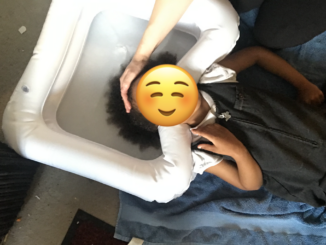Setting up the environment to help mitigate some of the sensory mismatch is the fourth tool you can use in parenting, teaching or whatever situation you might encounter. Some of these other things I’ve named over the course of this week are just specific versions of doing this. (Here are links to the first post, second post, and third post, in case you missed them!) Building a family culture where anybody has access to headphones or sound reducing items, or where everybody can walk away if they need a break, is helping set this up for the future.

Setting up an area where kids who need to seek tactile input, visual input, vestibular or proprioceptive input by themselves can help. For awhile when my two were younger we had mostly the living room where Apollo would play and the play room where Summer would play. I had noticed that when they were together they would fight over who got to turn on or off the light switches. So not only did Summer get free reign over the light switch in the play room, but I also put twinkle lights and a disco ball in there, and for a series of months she would just go in there and have a baby rave when she was like 2 and he was 3. We have intermittently had different climbing frames and hanging bars in our house. If we weren’t renting we would’ve had an indoor swing — we will in our next long-term house! We’ve had couch cushions all over the floor and mattresses and a trampoline on the floor.
And on the rare times when I’m feeling high energy I model using these things — jumping around, balancing on stuff, having a dance party. And on the more frequent times when I’m feeling low energy and the kids are feeling high energy, then I might swap the locations of two things or put a new item on an old item.

Something visually distinguishing helps kids remember what tools they have access to. It can be as simple as putting a stuffed animal on top of the nugget couch or the mini trampoline, or setting some paper and markers on it so they could go somewhere new and color. Try putting down something novel, as simple as a few cardboard tubes from toilet paper, or something “out of place”, like building a small tower with some of their blocks on top of an unstable surface to invite being knocked down. For older kids or strong readers you could put a silly sign on things. “Bounce on me!” with a smiley face or “I’m feeling bouncy!”
Having access to music is another big one, regardless of how you feel about screens or what screen rules you have in your house, if it’s possible for you to find a way to give kids access to their own music it can be incredibly self-regulating and doesn’t have to involve a screen or YouTube with a little setup work. We’re still working out how best to do this in our family. We tried a Yoto player which I think we tried too early, before Summer could really figure out its full potential. I’ve thought about just getting her an old old ipod and we may try that in the near future. We put stuff on the Alexa a lot. Sometimes she’s been known to just pick kids toys that make music and push the button on them over and over so she can dance for like fifteen seconds at a time. This could extend to music making options too, which again, could be as complex as a keyboard or as simple as having access to saved, recycled containers to play drums on. The capacity to make your own sound and hear it, with whatever strings need to be attached to that — do it in your room, at a set time, with headphones, whatever — is a really powerful tool that fits some of the sensory reasons why kids scream, yell, or make loud noises and one of the many ways in which they learn regulation and volume control through play.
These types of things can be really hard to figure out how to implement well in tiny living spaces, shared living spaces, or with other adults in the house who are not open to letting children be children or are threatened by kids’ sensory needs or are overwhelmed by their own. I understand that all these things can’t be perfect for everybody everywhere. But the more resources you can get in place, the more tools you have, the more you can maybe make it work for your unique situation. And the more language you have to describe it, the more you can figure out what the exact problem or the exact mismatch is, the more you can make it work too because you can articulate what exactly the problem is that you’d need to solve rather than just feeling like “they don’t get along” or “we don’t get along and I don’t know why”.
***
This is a link to a lecture, presentation, and handout on my website for “setting up calming sensory spaces in the classroom”. The reason I’m linking this is because it talks through the principles of how to set up the environment to meet sensory needs in a small, shared space. Those principles also apply at home even if you have more space and more resources, because the principles of understanding the sensory processing, and what would meet those needs, are the same. It’s like I’m explaining to the “lowest common denominator”—the least resources, the least space, the most need for quiet, etc—and you can “ramp up” from there as needed.
All that to say, it’s helpful if you are in a classroom OR if you are in a home!


